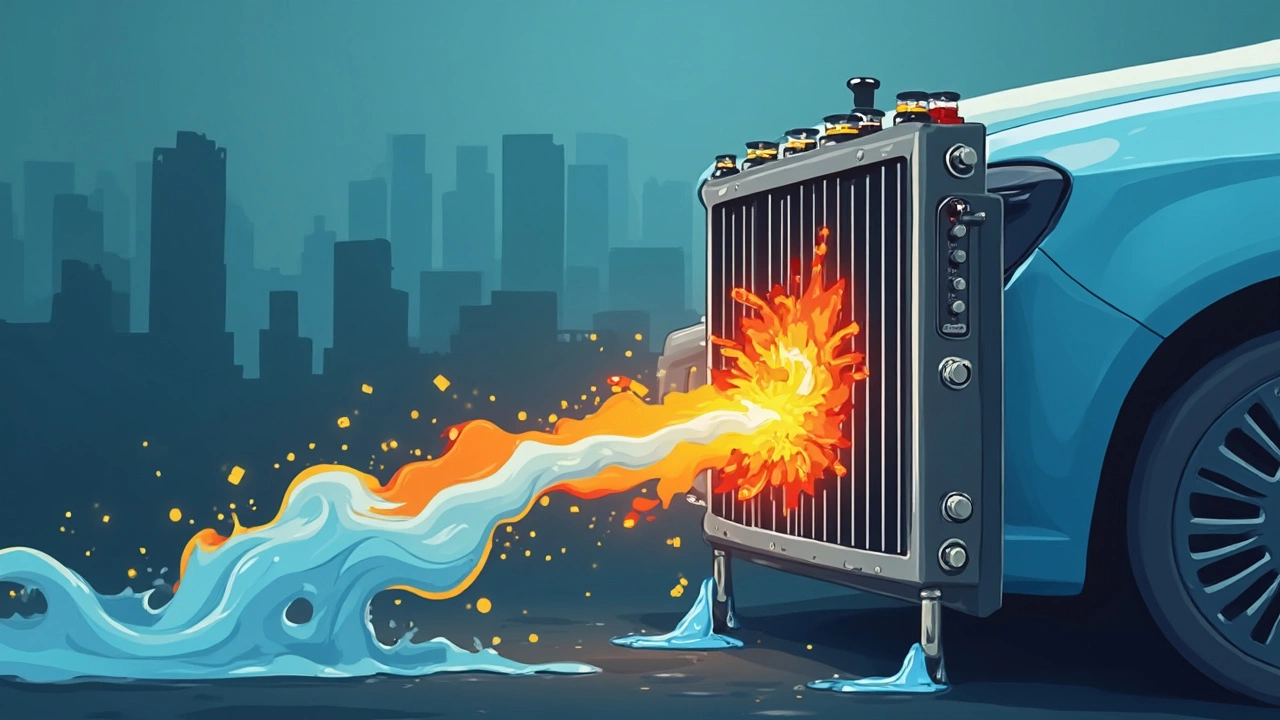 Apr, 22 2025
Apr, 22 2025
Ever seen someone pulled over on the highway with steam gushing out from their car? Nine times out of ten, a busted radiator is the real troublemaker behind that sad scene. Your radiator is what keeps your engine from frying itself. Ignore it for too long and you might as well start saving up for a new engine—or a new car.
Not fixing a faulty radiator doesn’t just mean dealing with an overheated car on a hot day. It sets off a chain reaction of problems, from mysterious coolant puddles under your ride to weird, sweet smells coming from under the hood. Even that slight temp gauge creep on your dashboard is your car pleading for help.
The crazy part? A simple leak or a clogged radiator can double—sometimes triple—repair bills down the road. Don’t trust a quick top-off with coolant to keep you rolling forever. A radiator problem never stays small for long, and waiting usually leads to breakdowns at the worst possible moment: traffic jams, road trips, or just when you’re already running late.
- Why the Radiator Is a Big Deal
- Immediate Effects of a Bad Radiator
- Hidden Dangers That Pile Up
- How Much Could It Cost You?
- Tips to Save Your Engine (and Wallet)
Why the Radiator Is a Big Deal
The car radiator isn’t just there for show. It’s your engine’s cooling lifeline. Every time you drive, your engine gets hot—sometimes hotter than 220°F (that’s enough to cook dinner). The radiator pushes coolant around the engine, soaking up all that heat and then releasing it as air flows through the grille while you move. Without it, your ride would overheat in minutes.
Here’s how it goes: Inside your engine are lots of fast-moving metal parts that create friction. Friction means heat—think of rubbing your hands together until they burn. The radiator’s job is to get rid of that heat before it boils your engine’s insides. If it fails, metal parts can warp, seals can melt, and you’re left with an engine that’s more scrap heap than street-ready.
It’s not just about keeping cool for comfort. Modern cars come with pricey aluminum blocks and rubber hoses that aren’t happy with extreme temps. Even a small coolant leak can cause the whole cooling system to go haywire, leading to blown hoses or, worse, a cracked engine block.
Want some quick real-world numbers? Take a look:
| Cost of Fixing Radiator Leak | Cost of Full Engine Repair |
|---|---|
| $150-400 | $3,000-7,000 |
You don’t need to be a mechanic to see which one’s easier on your wallet. So whenever you hear about a radiator problem, remember: it’s not something to brush off. It’s the difference between a cheap fix now and a headache later.
Immediate Effects of a Bad Radiator
When your car radiator isn't doing its job, you feel the impact quickly. The first sign is usually your temperature gauge inching up higher than normal. If you’re used to seeing that needle sit below halfway, and now it’s creeping up, that's your car telling you it’s about to have a bad day.
Overheating is almost immediate if the radiator can't cool the engine. You might spot steam coming from under the hood—think of it like your engine's SOS. Ignoring this leads to metal parts expanding and rubbing together, which can quickly turn into a seized engine. In other words: your car stalls, and it's not getting home on its own.
Another biggie? Low coolant levels. If the radiator has a leak, you’ll probably find green, orange, or pink fluid under your car after it's been parked. Not only does this hurt the cooling system, but it also causes the heater inside your car to blow cold air (not fun in winter). The coolant itself can give off a sweet smell when it leaks, so trust your nose if you catch that weird scent.
- Car radiator leaks can happen fast and often get worse on long drives.
- You might notice odd engine sounds—knocking or ticking—when things heat up too much.
- Sometimes, dashboard warning lights will flash, like the check engine or coolant symbol.
According to a survey of mechanics in the U.S., nearly 27% of emergency tow calls are because of overheating—and most of that starts with radiator issues. If you hear hissing under the hood after you turn the car off, take that as a clear sign your coolant is boiling somewhere it shouldn't be. Quick tip: never try to open the radiator cap when your engine is hot. The pressure can send boiling coolant flying.

Hidden Dangers That Pile Up
Ignoring a car radiator issue isn’t just inviting trouble—it's opening the door to a bunch of problems that sneak up on you. Sure, the car might limp along for a bit, but the damage is building up where you can't see it.
The first thing that usually happens: coolant leaks get worse. Even a tiny drip can turn your engine bay into a hot mess. As the coolant level drops, your engine’s cooling system loses its edge, and you start flirting with overheating—which is no joke. Once the coolant runs low, metal parts inside your engine get scorched and warped, and things can literally fuse together from the heat.
Then there’s the sludge. When coolant isn’t flowing right (maybe the radiator’s clogged or damaged), it turns into a nasty soup that gunks up everything. That sludge blocks tiny passages, which means less cooling and even more heat. Plus, that mess can wreck your heater core, so forget about defrosting windows in winter.
- Coolant leak = burned out sensors and damaged wiring from sticky fluid.
- Sludge buildup = less heat transfer + radiator clogged, so goodbye proper cooling.
- Low coolant = head gasket blowout—one of the top reasons for engine damage.
- Long-term overheating = piston rings and cylinder walls may get scorched, which means your engine basically eats itself alive.
A 2023 survey of repair shops found that fixing engine damage from ignored coolant leaks cost car owners up to three times more than the original radiator repair. It’s like skipping a dentist visit and winding up with a root canal.
Long story short? Not fixing a radiator snowballs into electrical headaches, catastrophic engine repairs, and sometimes even a totaled car. And that’s all from letting a small coolant leak or clog keep going.
How Much Could It Cost You?
Ignoring a car radiator problem is like ignoring a check engine light—your wallet’s about to take a hit. Here’s the not-so-fun part: a basic radiator repair usually starts around $150 to $400, covering minor leaks or hose replacements. But if you let the issue drag on, you’re looking at shelling out anywhere from $800 to $1,200 (sometimes more) just to replace the radiator itself.
But that’s just the beginning. If the radiator fails, you risk overheating the engine. A simple overheat can cost you $2,000 for a head gasket repair, and if the whole engine cooks? Welcome to the $3,500–$7,000 club for major engine replacement. I’ve seen folks pay even more because they waited until their car was totally undrivable.
| Repair | Average Cost (USD) |
|---|---|
| Coolant Leak Fix | $100 - $250 |
| Radiator Replacement | $800 - $1,200 |
| Head Gasket Repair | $1,500 - $2,500 |
| Full Engine Replacement | $3,500 - $7,000+ |
If you’re thinking about skipping the repair, think about resale value, too. Nobody wants to buy a car with a known coolant leak or past engine damage. You’ll face lowball offers or might not even get a buyer.
“Overheating due to a bad radiator is one of the most expensive mistakes drivers can make. Fixing a leak early costs a fraction of major repairs later.” — Car Care Council
Bottom line: Fixing a radiator early is cheaper, safer, and way less stressful than dealing with blown engines and busted budgets. If your temperature gauge is creeping up, acting now saves you a small fortune later on.

Tips to Save Your Engine (and Wallet)
Don’t wait for disaster before you look after your car radiator. There are a few simple things you can do to keep your ride cool—and your cash where it belongs.
- Check your coolant level often. Pop the hood every few weeks and make sure the coolant is between the min and max lines on the tank. If you keep having to top it up, you could have a hidden coolant leak—and that needs fixing, fast.
- Look for puddles or stains under your car. If you spot anything green, orange, or even pink under your parked car, don’t ignore it. That’s usually coolant, and it’s a sign your car radiator or hoses are leaking.
- Listen to your dashboard. If your temp gauge heads north of normal, pull over and let the engine cool down. Driving with an overheated engine can wreck it in minutes.
- Flush your radiator as recommended. Most mechanics suggest a radiator flush every 2-3 years or around 30,000 miles. Fresh coolant keeps everything flowing right and stops gunk from clogging things up.
- Don’t ignore the check engine or overheating warnings. Modern cars throw a fit on the dashboard if something’s off with the cooling system. Treat those warnings like an emergency, not a suggestion.
If you’re worried about the cost, here’s a quick breakdown—fixing a minor coolant leak may set you back $100-$200. A new radiator? Around $350 on average. But if you roast your engine from ignoring it, engine replacement can skyrocket past $4,000. That’s a simple decision.
| Problem | Average Cost (USD) |
|---|---|
| Coolant Leak Repair | $100-$200 |
| Radiator Replacement | $350-$900 |
| Engine Overhaul | $3,000-$4,500 |
The best tip? Fix small problems while they’re still small. Paying a little now beats paying a fortune later.